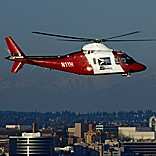Senator Proposes Adding Tougher Safety Requirements To FAA
Funding Bill
 Before Stacy Friedman lost her
sister Erin in the 2005 downing of a medical transport helicopter
in Washington, she never viewed the job as especially dangerous. In
the two years since the Airlift Northwest Agusta A109 helo carrying
nurse Erin Reed, nurse Lois Suzuki, and pilot Stephen Smith was
lost in Puget Sound, however, Stacy has become a crusader for
stricter helicopter ambulance safety standards.
Before Stacy Friedman lost her
sister Erin in the 2005 downing of a medical transport helicopter
in Washington, she never viewed the job as especially dangerous. In
the two years since the Airlift Northwest Agusta A109 helo carrying
nurse Erin Reed, nurse Lois Suzuki, and pilot Stephen Smith was
lost in Puget Sound, however, Stacy has become a crusader for
stricter helicopter ambulance safety standards.
Friedman, who lives near Sacramento, CA, is pushing for the
addition of terrain awareness systems and cockpit voice and data
recorders to medical ambulance flights. She has the support of
Washington Senator Maria Cantwell, who has suggested adding tougher
safety requirements to the FAA funding reauthorization bill now
making its way through Congress.
Those suggestions are opposed by many within the medical
transport industry, reports the Seattle Times. They say mandating
such systems onboard medical helicopters would drive up the cost of
lifesaving services, potentially grounding some operators -- while
not doing very much to improve safety.
"The reality is there are going to be sick people who are not
going to get health care because they cannot be flown," said Ed
Marasco, owner of CJ Systems Aviation Group. The Pennsylvania-based
company owned the Airlift Northwest helicopter that crashed in
Washington in 2005.
Marasco suggested a more cost-effective safety addition would be
night-vision goggles, so pilots could maintain visual references
when flying in the dark through clouds.
As ANN reported, the
helicopter carrying Erin Reed was returning to its base at
Arlington Municipal Airport (AWO) in low night IFR conditions,
after dropping off a patient in Seattle September 29, 2005. The
helicopter disappeared from radar just past 9:00 pm PDT, impacting
the water near Edmunds, WA. The NTSB ruled the probable cause of
the crash was loss of control in maneuvering flight for reasons
unknown.
A recent study by Johns Hopkins University School of Public
Health found helicopter emergency crews are 16 times more likely to
perish in a job-related mishap, than on average. According to the
FAA, there were 83 accidents involving medical transport
helicopters in a six-year period from 1998 through mid-2004.
 A separate 2006 study
conducted by the National Transportation Safety Board found most
fatal accidents involving medical helicopters occurred without a
patient onboard -- which might be due in part to tougher
regulations governing flights when patients are in the helicopter.
The FAA states pilots of helos transporting patients must maintain
at least two miles visibility at low altitudes. No such minimum
visibility requirement exists when flying without a patient,
according to the Times.
A separate 2006 study
conducted by the National Transportation Safety Board found most
fatal accidents involving medical helicopters occurred without a
patient onboard -- which might be due in part to tougher
regulations governing flights when patients are in the helicopter.
The FAA states pilots of helos transporting patients must maintain
at least two miles visibility at low altitudes. No such minimum
visibility requirement exists when flying without a patient,
according to the Times.
The Association of Air Medical Services sent a letter to the
Senate Commerce Committee in May, telling lawmakers the industry
has worked to improve safety over the years -- adding imposing new
regulations like the ones proposed would add "millions of dollars
to the costs of out-of-hospital care and decreasing public access
to needed emergency care — without a corresponding increase
in safety."
Stacy Friedman has travelled to Capitol Hill three times, making
a bit more inroads on each trip but failing to earn a face-to-face
meeting with lawmakers. On the last trip, she met with a member of
Senator Cantwell's staff, who suggested it would be easier to add
tougher safety standards to the FAA bill, than to push for new
regulations outright.
"He said sometimes when you ask for things, they happen,"
Friedman said, adding the proposed safety regulations are now in
the Senate Commerce Committee. "Things take a lot of time to make
happen in Washington."
 ANN's Daily Aero-Linx (04.15.24)
ANN's Daily Aero-Linx (04.15.24) Classic Aero-TV: 'No Other Options' -- The Israeli Air Force's Danny Shapira
Classic Aero-TV: 'No Other Options' -- The Israeli Air Force's Danny Shapira Aero-News: Quote of the Day (04.15.24)
Aero-News: Quote of the Day (04.15.24) Airborne 04.16.24: RV Update, Affordable Flying Expo, Diamond Lil
Airborne 04.16.24: RV Update, Affordable Flying Expo, Diamond Lil ANN's Daily Aero-Term (04.16.24): Chart Supplement US
ANN's Daily Aero-Term (04.16.24): Chart Supplement US




